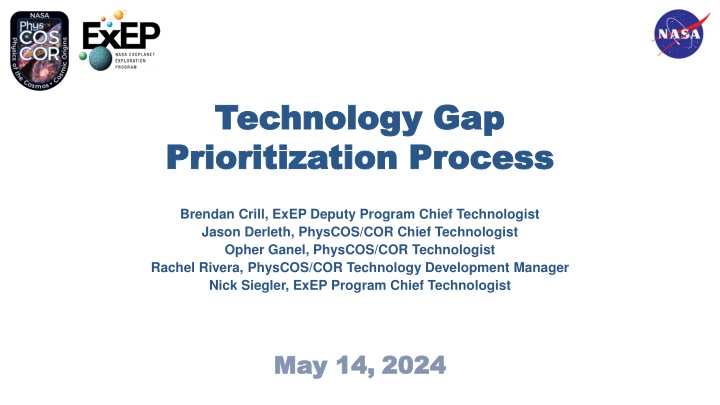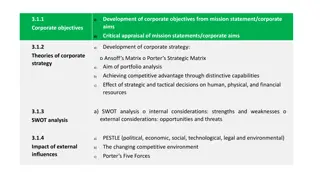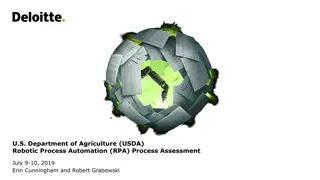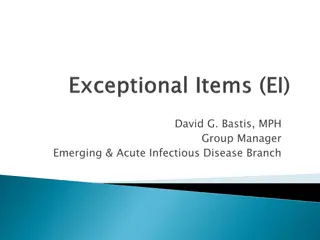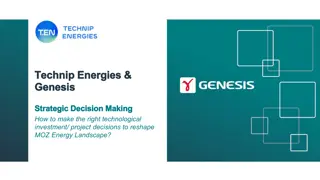Strategic Technology Development Process
This process is responsive to community input, informing strategic technology investments for the Program and beyond. It includes key steps such as prioritizing technology gaps, making investments, and monitoring technology developments.
Download Presentation

Please find below an Image/Link to download the presentation.
The content on the website is provided AS IS for your information and personal use only. It may not be sold, licensed, or shared on other websites without obtaining consent from the author.If you encounter any issues during the download, it is possible that the publisher has removed the file from their server.
You are allowed to download the files provided on this website for personal or commercial use, subject to the condition that they are used lawfully. All files are the property of their respective owners.
The content on the website is provided AS IS for your information and personal use only. It may not be sold, licensed, or shared on other websites without obtaining consent from the author.
E N D
Presentation Transcript
Technology Gap Technology Gap Prioritization Process Prioritization Process Brendan Crill, ExEP Deputy Program Chief Technologist Jason Derleth, PhysCOS/COR Chief Technologist Opher Ganel, PhysCOS/COR Technologist Rachel Rivera, PhysCOS/COR Technology Development Manager Nick Siegler, ExEP Program Chief Technologist May 14, May 14,2024 2024
What Well Cover Today Overview of NASA Astrophysics Division (APD) strategic technology development Why we prioritize technology gaps Our gap prioritization process Our starting point for 2024 2
APD Funds All Levels of Technology Maturity to Enable Future Missions The Astrophysics Research and Analysis (APRA) program: Solicits basic research proposals relevant to NASA s astronomy and astrophysics programs, from basic principles through flight missions (Technology Readiness Level, TRL, 1 through 9); includes suborbital investigations (balloons, sounding rockets); award duration up to five years. The Strategic Astrophysics Technology (SAT) program: Matures key technologies that address the needs of future strategic missions, taking them from proof of concept through validation in relevant environment (TRL 3 to 6); award duration up to three years. The Internal Scientist Funding Model (ISFM) program: Similar to SAT or APRA awards. Awarded to NASA scientists. Flight projects: Address final maturation (TRL 6 through 9) proving technology flight-worthiness for mission-specific applications. The strategic technology gap prioritization informs the SAT program 3
Strategic Technology Development Sequence 1. The Decadal Survey Prioritizes the science Develops an implementation plan 2. APD 3. The astrophysics community Identifies strategic technology gaps 4. Tech Management Board (TMB) Prioritizes technology gaps 5. APD Solicits and makes investments 6. The astrophysics community Develops and matures technologies 7. The Program Offices Monitors, tracks, and advocates for technology developments 4
Strategic Technology Development Process Strategic Technology Development Process Process is responsive to community input and informs strategic technology investments for the Program and beyond investments for the Program and beyond Process is responsive to community input and informs strategic technology We are here We are here We are here ATU - Technology Highlights - New Award Announcements - Infusion and TRL Updates ATUs to be published between ABTR publication years 5
What Are the ABTR and ATU? The Astrophysics Biennial Technology Report (ABTR) is published every other year, summarizing APD technology development activities over the prior two years Provides an overview of APD technology development activities and processes ( big-picture investment summary and metrics). Lists current technology development portfolios, highlights significant progress, identifies technology infusions, and announces new SAT award selections, if any. Provides a prioritized list of technology capability gaps to inform SAT proposal calls and selection decisions for the coming two years, as well as future technology development planning. The Astrophysics Technology Update (ATU) is published every other year (between ABTRs) summarizing APD technology highlights over the prior two years. Provides an overview of APD technology development activities and processes ( big-picture investment summary and metrics). Highlights significant progress, identifies technology infusions, and announces new SAT award selections, if any. In 2024, the first ATU was published in the same year as the upcoming ABTR, to highlight recent Astrophysics technology development news at the SPIE meeting in Yokohama. This ATU includes only highlights. 6
Why Prioritize Gaps? Objectives Identify technology gaps applicable and relevant to Astrophysics strategic objectives as described in the Decadal Survey, AIP, and any other strategic guidance from APD Rank these technology gaps with respect to strategic alignment, benefits and impacts, urgency, and cross-cutting capabilities to inform APD strategic technology development solicitation, planning, and investments Purposes Inform the SAT solicitation and other NASA technology development programs (APRA, SBIR, and other OCT and STMD activities) Inform technology developers of APD technology gaps to help focus efforts Inform selection of awards to align with APD goals and science objectives Improve transparency and relevance of APD technology investments Inform and engage the community in our technology development process Leverage technology investments of external organizations by defining our strategic technology gaps and identifying NASA as a potential customer 7
Technology Gap Prioritization Process 1. 2. Technology gaps are solicited from the community (current cycle due date is Jun 3rd, 2024) Program technologists from the three POs review the gap inputs and assign each to the Program that would be most impacted by closing it (Gap Distribution) Each PO consolidates its assigned inputs The integrated gap lists are sent to the COPAG Executive Committee (EC) or PhysPAG EC as appropriate for review before prioritization of PhysCOS/COR gaps The TMB/ExoTAC review and prioritize technology gaps in Jul/Aug TMB membership is diverse and includes senior members of APD and POs, STMD, and subject matter experts The ExoTAC is a standing independent expert panel advising ExEP Prioritization is based on a published set of criteria addressing strategic alignment, benefits and impacts, urgency, and scope of applicability (see next slide) After APD approval, the prioritized list is used to inform the SAT solicitation amendment in Sep, posted on PO websites, and published in the ABTR 3. 4. 5. 6. 8
Prioritization Criteria Address Strategic Alignment:How well does the technology align with astrophysics science and/or programmatic priorities set out in the Astro2020 Decadal Survey? Benefits and Impacts:How much impact does the technology have on applicable missions? To what degree does it enable and/or enhance achievable science objectives, reduce cost, and/or reduce mission risks? Urgency:Given the anticipated difficulty of maturing from the current TRL to TRL 6, assessed against the time available until anticipated launch and/or other schedule drivers, how urgently does the gap need to be addressed? Scope of Applicability:How crosscutting is the technology? How many Astrophysics programs and/or mission concepts (strategic or other) would benefit by closing the gap? 9
Technology Gap Submission Form Technology Gap Submission Form Technology gap submission form can be downloaded here: https://apd440.gsfc.nasa.gov/tech/Tech_gap_form_2023-12-11.docx 1. Name of technology capability gap 2. Strategic Missions enabled or enhanced 3. Description of technology capability needed 4. Description of quantitative/ measurable performance goals and objectives to fill this capability gap 5. Assessment of current state-of-the-art TRL 6. References for TRL justification 7. Scientific, engineering, and/or programmatic benefits of achieving this capability (filling the gap ) 8. Potential applications and relevant mission(s) (not limited to strategic Astrophysics missions) 9. Urgency, estimated launch date or other schedule driver, complexity, and difficulty 10
Technology Capability Gaps Guidance Technology Capability Gaps Guidance Focus on technology gaps associated with missions prioritized in Astro2020 and relevant programmatic directives Submit technology gaps directly applicable to Program objectives. Don t submit gaps beyond our charter (e.g., ones associated with launch vehicle, rover, avionics, spacecraft systems, etc.) Don t include gaps that don t require technology development, are not well defined, and/or are redundant (duplicate, similar, or subsets of other needs) Submit inputs as technology capability gaps between the current state-of-the-art and what is needed to achieve the science objective targeted, not specific implementations Don t endorse or advertise any organization, mission, or person Don t include proprietary or ITAR/EAR-sensitive information 11
Sample Excerpt of 2022 Tech Gap Details Sample Excerpt of 2022 Tech Gap Details 12
Full 2022 Technology Gap Priorities List Full 2022 Technology Gap Priorities List Tiers are in descending priority order. Gaps within any given tier are considered equally prioritized which is why they are arranged alphabetically within each tier. Gaps in Tiers 1-4 are automatically included in the following prioritization cycle so there is no need to resubmit them unless you want to propose edits Gaps in Tier 5 are not strategic and are thus excluded from the following prioritization cycle. This 2022 Prioritized Gaps List can be downloaded here: https://apd440.gsfc.nasa.gov/images/tech/2022tiers.pdf 13
How the How the PhysPAG PhysPAG and COPAG ECs Help and COPAG ECs Help 1. Refine gap information as needed to make each gap unique, complete, accurate, and compelling 2. Ensure entries are phrased as capability gaps, not specific solution implementations 3. Combine similar/overlapping gaps when separate prioritization doesn t make sense 4. Add any gap(s) the EC/ExoTAC think is missing 5. Identify or concur with gaps considered for removal from being prioritized for the following reasons: Don t require technology development (TRL 6 or is an engineering problem); Aren t sufficiently described or defined; Aren t relevant to any APD strategic mission; and/or Are outside of our purview (e.g., launch vehicles, spacecraft or rover subsystems, etc.) 14
What Missions Are Considered Strategic? What Missions Are Considered Strategic ? Strategic Astrophysics missions are ones APD is developing, participating in, or interested in, to respond to high-priority science questions or mandate. These are missions identified as priorities by the current Decadal Survey and/or identified for execution by APD. Strategic missions are usually large and multi-purpose and are generally assigned to a NASA Center to implement, with science instruments and platform components selected in open competitions. Strategic missions relevant for technology gap submission during the 2024 prioritization cycle are shown below in blue: Decadal Survey flagship missions: HWO, far-IR flagship, X-ray flagship Decadal Survey Probes: Far-IR Probe, X-ray Probe, CMB Probe Strategic non-mission activities: o Decadal Survey high-priority activities: Time-Domain/Multi-Messenger (TDAMM) o Other fields mentioned in Astro2020 (e.g., gamma ray, cosmic rays, etc.) 15
Starting Point for 2024 Gap Prioritization Starting Point for 2024 Gap Prioritization All Tier 1-4 gaps from 2022 are automatically included (no need to resubmit unless proposing edits). All Tier 5 gaps from 2022 are automatically excluded, as they are not strategic. All gaps submitted by the community by June 3rd will be considered. The leadership of the HWO Science, Technology, and Architecture Review Team (START) and HWO Technical Assessment Group (TAG) plans to submit authoritative HWO technology gaps (per Matt Bolcar). 16
Summary Summary The POs are prioritizing technology gaps for APD this summer. The due date for entries is June 3rd. Gaps submitted later will be considered in 2026. The HWO START/TAG leadership plans to submit a set of authoritative HWO gaps. Unless you want to propose an edit, there s no need to resubmit 2022 gaps o Gaps in Tiers 1-4 are automatically included o Tier 5 gaps are automatically excluded. The 2024 prioritized Astrophysics Technology Gaps list will be published by Sep 30th. Technology gaps that do not enable or enhance strategic Astrophysics missions can be, and often are funded through other programs (e.g., APRA, RTF, ISFM, etc.) APD invests in facilities to close capability gaps, but this is in parallel to the technology gaps process. 17
